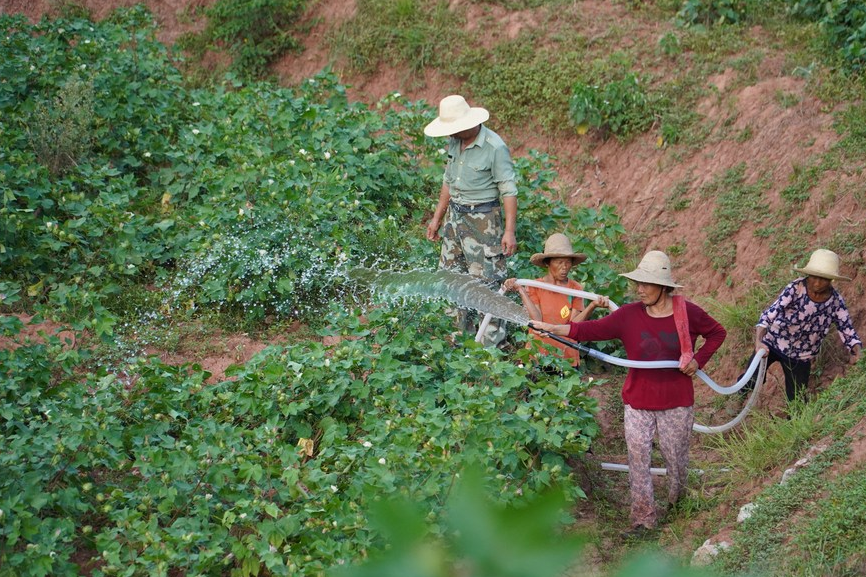
Farmers water crop plants in Beiping Village of Cili County, central China's Hunan Province, Aug. 17, 2022. (Xinhua/Zhang Ge)
Amidst the sound of cicadas, Zhang Bingju, a grain grower in Changyuan Village, under the county-level city of Linxiang in central China's Hunan Province, led a team to replace his pump with a more powerful one.
The replaced pump is at the second level of a five-level lift irrigation system. Due to the severe drought this year, the nearby ponds and reservoirs have dried up, while Huanggai Lake, 2 km away from Zhang's farmland, has abundant water.
Even though some rice paddies are nearly 3 km away from Huanggai Lake and approximately 60 meters higher than the lake, over 30 pumps were newly installed to lift the water to farmland through water bodies such as lakes, aqueducts, reservoirs, and mountain ponds, according to Zhang.
"After five times of lifting, 3,800 mu (about 253 hectares) of our rice fields are able to get water in time," Zhang said with relief.
Affected by the recent drought, the water level at the Chenglingji hydrometric station of Dongting Lake, China's second-largest freshwater lake, receded to 22.39 meters at 8 a.m. on Friday, the station's lowest level in August over the past 30 years. As the dry weather continues, around 4.65 million mu of crops have been affected by the drought in Hunan.
Located in the Dongting Lake region, Yueyang City is a major granary south of the Yangtze River. It is currently a critical period for growing middle- and late-season rice.
The municipal government of Yueyang City, which administers Linxiang, has stepped up efforts to ensure agricultural water supply to cope with the drought.
Wenfa Village in Yueyang County, Yueyang City, is at the far end of the Tieshan irrigation area, with more than 2,300 mu of rice paddies. Due to the complex terrain, it takes up to 12 levels of water lifting to use the water in the nearby pond.
According to Zhou Rongyu, Communist Party chief of the village, the local electricity company started to set up power lines and install electricity meters starting from the end of July to meet the electricity demand for water pumping.
"Fortunately, the impact of the drought was minimized thanks to the collaboration of all departments," said Zhou.
"Since April, we have repaired more than 20 sections of water channels. In mid-July, when the drought started, we urgently dredged 22 km of the Yuemi Channel," said Zhao Hongding, an official with the local water resources department.
In the southern Tieshan irrigation area alone, during the 47 days since the gates opened to release water, more than 56 million cubic meters of water have been supplied, saving 500,000 mu of farmland from more serious impact of the drought.
The provincial hydrology and meteorological departments had predicted that the low rainfall would start from July this year. As early as in mid-June, reservoirs in the province had been instructed to preserve water in advance, said Luo Yijun, director of the provincial water resources department.
"The water saved then is now an invaluable resource in our fight against drought," Luo said.
Category
Multi-level Irrigation System Helps Ensure Production Amid Rare Drought
Contributor
Multi-level Irrigation System Helps Ensure Production Amid Rare Drought
Country
Technical Solution

